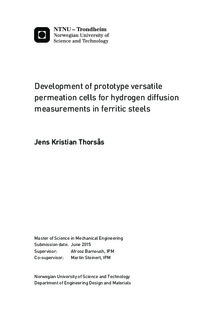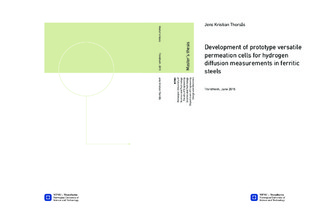| dc.description.abstract | This thesis provides three different design solutions for hydrogen permeation cells based on Devanathan and Stachurski method for hydrogen charging.
The first part of the thesis is built as a background analysis for the development processes. The focus lies on how the experiment functions and its critical parts, and how others have solved it. Available systems have been analyzed and studied, and more are presented from the literature. A user is followed to further inspect the needs of the experiment both in terms of simplicity and function. This information is gathered, and it is created a table of what the system must and should contain.
For the industrial system, the development is built up by first suggesting concepts for the crucial parts in the system. The crucial parts are considered as the parts not being bought by another producer. Several solutions are presented to each of the parts, before two different concepts are presented. These concepts are the tube and the box. The individual parts are discussed in terms of how they would perform under the given conditions. After this a final design is suggested and presented as CAD-models. One critical part of the industrial cell is the effectiveness of the heating with regards to heat loss. Calculations are performed that show that the fluid inside the cells should be able to be heated to the desired temperature in less than one hour, while cooling will take longer time than wanted.
The laboratory system will use water for heating. Two concepts are suggested. This can be done by either a double walled cylinder made of glass, or by using tubes. For the double walled cylinder two different CAD-models are presented: One that focuses on using a sample holder, the other that focuses on pressure to seal the electrolyte from the outside. Calculations of flow through the double walled cells are done, and it is suggested that a positive displacement pump with a capacity of 5.4 l/min is used to make sure the water is able to heat the whole cell. For the checking the stresses in the cells, a FEA is done, to make sure that the glass will not break. The force is reliant on the pressure needed to compress the O-rings for sealing. An approximation with a force of a 1000N on the edge of the cylinder gives stresses that are at the most 37.8 MPa. This will not break the glass and will compress an O-ring. To find out if the O-ring seals it must be calculated non-linearly, but it is easier to test.
The Nano-indenter system has different problems than the other systems. The cells are vertical and bubbles will attach easier to the surface of the sample. Testing is done to determine which method that can be utilized to remove the bubbles. After testing a system using flow as the bubble removal is suggested. The development progresses in iterations by continuously improving problems that can occur during the experiment until a final suggestion is made. It is emphasized that this model should be function tested under better conditions. | |

